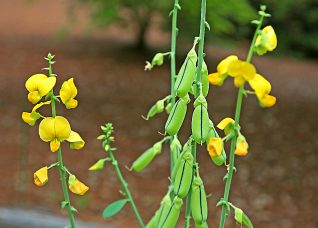
MinerAlert

MinerAlert
Crotalaria longirostrata
Fabaceae
Chabeh (Argueta, 1994).
Chipilín, Chepil, Chepilin (Argueta, 1994; White, 2003; Quattrocchi, 2012).

This perennial leguminous shrub, as well as a related species, C. guatemalensis, are native to Southeastern Mexico and Central America (Quattrocchi, 2012; Mabberley, 2008; Argueta, 1994).
Principally the stems and leaves.
The stems and leaves are edible and have been used as a potherb as well as a medicinal plant for centuries among various indigenous peoples of southern Mexico and various countries in Central America.
The plant is considered to be nutritious as well as medicinal. Its leaves are high in various minerals, such as iron, calcium, and magnesium. They are also high in various B vitamins including thiamine, niacin, riboflavin as well as vitamin C and beta carotene. Soups and tamales made with this plant are eaten to prevent anemia. The leaves are decocted in water to prepare a tea to induce sleep, as well as for its calming action in treating nervous disorders. The tea can be sweetened with honey (Argueta, 1994).
Safety/Precautions:
Before you decide to take any medicinal herb or herbal supplement, be sure to consult with your health care professional first. Avoid self-diagnosis and self-medication: Always be on the safe side!
Argueta A. Atlas de la Medicina Tradicional Mexicana (Vol. 1).
México, D.F.: Instituto Nacional Indigenista; 1994.
Mabberley’s Plant Book 3rd ed.
London: Cambridge University Press; 2008.
McKenzie R. Australia’s Poisonous Plants, Fungi and Cyanobacteria.
Victoria, Australia: CSIRO Publishing; 2012.
Pfrohne D, Pfander J. Poisonous Plants 2nd ed.
Portland OR: Timber Press; 2005.
Quattrocchi, U. World Dictionary of Medicinal and Poisonous Plants (Vol.1).
Boca Raton, FL: CRC Press; 2012.
Wagstaff J. International Poisonous Plant Checklist: An Evidence-Based Reference. Boca Raton, FL: CRC Press; 2008.
White R. Elsevier’s Dictionary of Plant Names of North America Including Mexico.
Amsterdam: Elsevier; 2003.